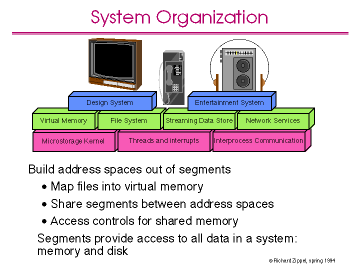
Back to the previous slide, on to the next slide or up to the storage overview
We believe that the microstorage architecture just described lays the foundation to a new type of operating system that is more modular and flexible than existing operating systems. The storage model with which applications are built will not be the segment model provided by the microstore, but rather the model provided by the different storage servers. If additional performance is required, different storage servers can be constructed, but the semantic level at which the application builder will work will be higher. For instance, it is important that the application developer not specify that a large block of data be stored on disk in sequential blocks, but rather indicate the throughput and latency requirements the application places on the data. The responsibility of the microstore is to provide the data within those parameters.
While microkernelized operating systems were great conceptual simplifications of the previous organizations, the microstorage architecture provides additional simplifications. As shown in the figure, the lowest layer of the operating system is divided into three simple components: the microstore, the interrupt and thread manager and the interprocess communications manager. Notice the parallel in this division and the general partitioning of systems' mechanisms discussed earlier: